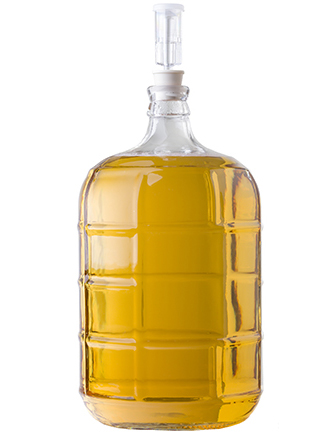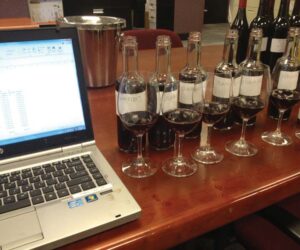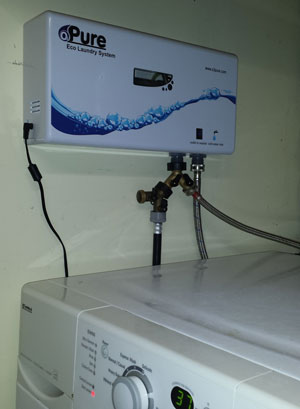Q I’ve been reading a number of articles about preventing oxidation of the wine I’m making. The articles suggest “topping off” the carboy. What do I use to top off the carboy?
I’m making a Sauvignon Blanc and it looks golden in the carboy. Just wondering if I needed to do something while in secondary fermentation?
Anthony Ambrose
Lancaster, New York
A As I explain in my book, The Winemaker’s Answer Book, oxygen can be a friend of wine (especially during active primary fermentation) but is more often its enemy. One of the biggest jobs of being a winemaker entails minimizing oxygen (air) contact in our aging wines by keeping our containers 100% full, or “topped up.” The term “topping” or “keeping wines topped up” refers to either a) storing your wine in a completely full vessel or b) adding some wine to a partial vessel to render it full. This, along with proper sanitation, pH management, and adequate levels of sulfur dioxide (all topics amply discussed in my book and in WineMaker magazine) will keep your wine from getting browned (oxidized), something that is very important, especially for delicate white wines like your Sauvignon Blanc.

Speaking of delicate Sauvignon Blancs, it’s pretty uncommon for folks to take their Sauvignon Blancs through the secondary, or malolactic fermentation (MLF). This is because most producers of the variety like its crisp refreshment, good acidity, and floral and grassy aromatics, with winemaking choices to keep it that way. The MLF deacidifies wines as the stronger malic acid is transformed into the weaker lactic acid. There are also aromatic and textural changes that happen with malolactic fermentation that may or may not align with your goals for a Sauvignon Blanc. Aromatically, MLF tends to produce notes of cream, butter, or even short-crust pastry, while the finish may lengthen and the mouthfeel round out a bit. So, you could add sulfur dioxide to your wine (and protect it from oxidation in one fell swoop!) to arrest the malolactic bacteria and be perfectly within traditional Sauvignon Blanc winemaking style standards. You could also keep it going through MLF; it’s up to you. Which brings us back to keeping wine topped up . . .
When our wines are going through MLF they are producing some amount of carbon dioxide gas, which helps protect them a little bit from the ravages of oxygen. However, MLF can tick along slowly at a snail’s pace, so it’s not wise to assume a nice, thick “blanket” of protective carbon dioxide gas is being produced by your malolactic bacteria. You’ll need to give your wine a helping hand in order to protect it during this time. MLF is best done in a fully-topped up container that’s capped with a fermentation lock to allow carbon dioxide gas to escape, but which won’t allow air to come in. These can be picked up (along with the special carboy bungs to fit them onto) at your friendly local winemaking or homebrewing supply store (or online).
Now I know what you’re probably going to ask: “What if I only have four and a half gallons (17 L) of wine in a five-gallon (19-L) carboy? How can I possibly get this carboy topped up?” There are a few solutions to this perennial home winemaker’s dilemma. I was speaking to someone from a large home winemaker’s group in Sonoma the other day and this very topic came up. One of my suggestions was for club members to band together to share and swap topping wine for exactly this kind of situation. Commercial winemakers usually have no issue with breaking down a barrel into kegs and carboys in order to do a topping session (barrels usually need to be topped monthly) but for small-scale winemakers dealing with glass carboys and small bottle volumes can be a real challenge.
When our wines are going through MLF they are producing some amount of carbon dioxide gas, which helps protect them a little bit from the ravages of oxygen.
Asking friends and fellow enthusiasts for help in this department is a natural step to take. Don’t feel like you have to exactly match the wine you’re topping up with either. Cabernet Sauvignons, Malbecs, Cab Francs, and Merlots all “play well together” and a light white wine can even be used to top up a rosé. Sure, it might dilute the personal pride you take in producing “your” wine a little, but if you can share a half-bottle of your Zinfandel with a buddy and she can give you a half-gallon (2 L) of clean Chardonnay to top up your Sauvignon Blanc, it’s a win-win.
If you’re not a member of a winemaking community like that or don’t want to use someone else’s wine (which I do understand) you can try to add some displacement objects to your carboys to take up space and raise the level of wine in your vessel. I’ve known folks to use marbles, glass floral arrangement beads, or even stainless-steel pie weights to displace wine and raise the levels in their containers. Basically, if it’s neutral (glass, fired ceramic, Pyrex, or stainless steel is best), sanitizable, and will fit into your container, it’s fair game.
Last ditch for topping wine? I’ve said it before and am not too proud to give you permission here — go out and buy some. Find a wine at your local grocery store that you think is the best match to yours and use it to top up your containers. Better a $15 bottle of Sauvignon Blanc than a spoiled, almost full, five-gallon (19-L) carboy. Do note, however, that commercial winemakers are not allowed to do this; this is for the home producer only. Also do be aware that almost any commercial wine will have an appreciable level of sulfur dioxide in it and won’t be compatible as an addition for wines still going through MLF. If you swap any topping wine with a buddy, be sure to check its SO2 status before adding it to your wine as malolactic bacteria are extremely sensitive to SO2.
All of the above being said, if it were my Sauvignon Blanc, I’d rack it out of the carboy into as topped off a situation as possible and adjust the free SO2 up to 25–30 ppm. If you’re worried about the color getting too golden and it’s untopped and going through malolactic fermentation, I’d cut off the MLF, get it on some sulfur dioxide, and get it topped up, no matter which method I had to use in order to do it.
Q This is my first time using a fining agent in my wine. after you use a fining agent will there be sediment again at the bottom of the fermenter? Do you need to filter wine after using a fining agent? Thanks for your help.
Kieran Ridley
Perth, Australia
A Indeed, after using most fining agents there will be a layer of sediment generated and you’ll need to rack the wine off of it accordingly. Fining agents, by definition, are introduced into a wine to interact with whichever of the wine compounds you are trying to mitigate or reduce. For instance, bentonite is a natural clay used for centuries as a fining agent. The clay is dissolved in water then is mixed into the wine as a slurry, where it combines with proteins, forms larger particles and “pulls” the proteins out of solution before settling by gravity as a layer of sediment. Sometimes proteins (egg whites are an ancient and still-effective example) are added in order to react with excess tannins, forming larger particles that fall to the bottom of barrels, kegs, or carboys.
If you can get a good, compact, settled layer it’s not necessary to filter a wine, unless you want to. Be sure to read package instructions carefully and use the correct doses — with fining agents the danger is often over fining. Too much bentonite can pull out compounds that can contribute to mouthfeel and flavor. You also don’t want to pull out too many tannins, for instance. Red wines need them for structure and balance and to age appropriately. For this reason, I always tell people to do bench trials; the aim is to find the minimum dose of a specific fining agent to use in order to achieve the result you’re looking for.
If you’ve followed instructions carefully and haven’t over added, and if you’re patient, it’s likely you’ll get a good, settled layer off of which you can just rack the clean, fined wine. Proper settling can be encouraged by cooler temperatures and by obviously not moving the wine around. If you don’t get a good settle, however, you may eventually have to filter your wine in order to get a clear product and to exclude the fining agent.
Q In your article “Malolactic Fermentation After Cold Stabilizing” https://winemakermag.com/wine-wizard/malolactic-fermentation-after-cold-stabilizing you mention that malolactic fermentation (MLF) may start back up after cold stabilizing when the wine warms back up.
For me, as in your article, MLF was underway albeit somewhat slowly; I believe because the pH of the different wines was running low, ~3.2–3.3 and ~11% ABV. I didn’t want to miss the window of cold nights in my upstate New York garage, so mid-February I placed the carboys out in the garage. After One month I brought them back inside. The next day I performed a chromatography test to verify MLF was not complete. I then added 1⁄2 the recommended dose of opti-malo plus and stirred it in gently. I did not rack the wine because I was concerned about subjecting the wine and MLF bacteria to oxygen.
• Should I have racked the wine?
• Should I be concerned that some of the tartrate crystals that have fallen out will be mixed back into the wine or will they remain as crystals never to become part of the solution again?
• How concerned should I be about subjecting the MLF bacteria to atmosphere? I can purge the carboys with CO2 if you think that would help.
Don Catharine
Burnt Hills, New York
A For those readers who are not familiar with the article referenced, I talk about how it was likely a reader’s malolactic fermentation would pick back up again when the weather warmed up again in the spring (he wanted to over-winter his wine undergoing MLF outside in order to help it get cold stable). It sounds like you also decided to take advantage of a cold spell in an attempt to get your wine cold stable and are hoping your malolactic fermentation will reignite now that you’ve brought it inside . . . and you have a few questions about cold stability in addition. I like that you’ve added some ML bacteria nutrients (Opti-Malo Plus is a good choice), which are especially important as ML bacteria are notoriously fastidious, in that to fully function they have very specific nutritional needs.
A little background on cold stability: Grape juice naturally contains tartaric acid and potassium, which can combine to form a salt called potassium hydrogen tartrate. Also known as KHT, potassium bitartrate, or cream of tartar. This salt can exist in a soluble form, wherein it is completely dissolved into grape juice, must, or wine. As alcohol levels increase during fermentation, however, and especially if temperatures drop during storage, these salts can precipitate out as a solid. If you’ve ever seen clear, sandy crystals at the bottom of your wine bottles or carboys, it’s a good chance you’re looking at sediment that contains a lot of KHT crystals.
A little background on cold stability: Grape juice naturally contains tartaric acid and potassium, which can combine to form a salt called potassium hydrogen tartrate.
Winemakers often like to force this precipitation to happen before bottling so the crystals don’t turn up in the finished wine bottles. Commercial wineries almost always cold stabilize their white and rosé wines because they don’t want to scare consumers by thinking there are glass shards in their bottles of wine. By getting the wine cold (and sometimes also adding additional solid KHT as “seed crystals”), we can encourage the formation and precipitation of KHT crystals during barrel or carboy aging. The resulting wine (as long as it’s racked or filtered off the crystals, see below) will be more “cold stable”, i.e., it can be subjected to cold temperatures in the future and fewer (or no) crystals will emerge. There are different ways of assessing a wine’s cold stability and the whole topic of the tests, their interpretations, and how to get a wine cold stable has been covered elsewhere in the magazine (and would take way too much space and time to address fully here). So, I’ll just get right to your specific questions.
Should I have racked the wine?
• After a wine is chilled down and KHT crystals have precipitated out, it’s important to either rack or filter the wine off of them so that they don’t re-dissolve into the wine after it warms up. A wine is only stable for the temperature it was filtered or racked at, i.e., if your wines outside got down to 32 °F (0 °C) but then when they came back into your garage they warmed up to 45 °F (7 °C) before you got around to separating the wine from the solids, the wine is only considered “cold stable” to 45 °F (7 °C), not 32 °F (0 °C).
Should I be concerned that some of the tartrate crystals that have fallen out will be mixed back into the wine or will they remain as crystals never to dissolve back into the solution/wine again?
• See earlier for some nuance. If the wine warms up there’s a good chance some of the KHT crystals will re-dissolve into the wine as potassium and tartaric acid, making those same components available for precipitation in the future. For this reason, it’s important to either rack or filter off of the precipitate.
How concerned should I be about subjecting the MLF bacteria to atmosphere? I can purge the carboys with CO2 if you think that would help.
• Protecting your wine from air (a mix of mostly nitrogen and oxygen) is always a good thing, even when it’s going through MLF. The small amount of carbon dioxide gas produced by ML bacteria isn’t enough to completely protect the wine so it’s a good idea to supplement here. Similarly, even though the wine is technically fermenting, it’s a
good idea to maintain it in as topped up of a situation as you can.
So, to conclude, that’s great you’ve pushed your wine closer to being cold stable, but it is important to separate the precipitated potassium bitartrate crystals from the wine by racking or filtration, to keep oxygen excluded, and to keep containers topped up.
An alternative to traditional cold stability, where we chill wine down, seed it with KHT crystals, then rack or filter, is to use carboxymethylcellulose (also abbreviated to “CMC”). Solutions are available through most commercial winemaking supply houses. CMC is clear, aromatically and flavor-neutral, and basically acts as a physical deterrent to crystal formation. Essentially, it disrupts the crystallization process and prevents KHT crystals from happening in the first place. This is a rather newer way of aiding cold stabilization and only works 100% of the time if one’s wine is not “too unstable.” To determine if your wine is a candidate for CMC, send a sample to ETS Labs in St. Helena, California for a test called the “Degree of Instability —Tartrates” or “DIT.” In the panel of results you’ll get back, if the “rate of electrodialysis” is <24%, then your wine is a candidate for CMC addition, i.e., it’s stable enough and the CMC will push it over the edge and make it stable. CMC (a common product is “Celstab,” sold by Laffort USA) is added at a rate of 1 mL per liter wine, right after final filtration and just before bottling.







